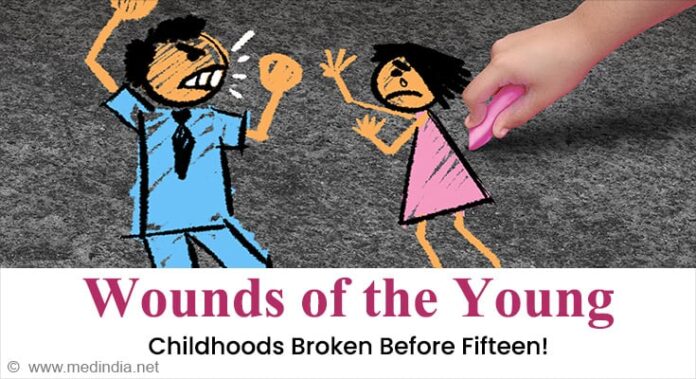Nearly 70% of sexual assaults occur to children, says a study.
- 70% of all reported sexual assaults occur to children under 16 years
- Children with disabilities are at higher risk for sexual abuse
- One in five women and one in seven men globally face sexual abuse by the age of 15 years or younger
Behind closed doors, in classrooms, and even on bustling streets, child sexual abuse (CSA) is a hidden crime that wears many faces and knows no boundaries. It is not limited by geography, wealth, or social status (1✔ ✔Trusted Source
Understanding the Scope of Child Sexual Abuse: Challenges and Opportunities
Go to source
).
Child sexual abuse includes engaging in sexual activities with a child, indecent exposure, child grooming, and child sexual exploitation. In areas where child labor is prevalent, CSA is not limited to a single environment; rather, it traverses numerous institutions and communities. This covers the homes, schools, and internet sites where teenagers are subjected to exploitation and abuse.
Threads of Child Abuse
- Physical Abuse: Physical abuse often does not occur in isolation but as part of a pattern of behaviors including authoritarian control, anxiety-provoking behavior, and a lack of parental warmth. Bruises, scratches, burns, fractures, cuts, and rough treatment that may be repeated and lead to physical abuse.
Sexual Abuse
When a parent or older adolescent mistreats a child for sex, it is known as child sexual abuse (CSA). Sexual abuse refers to the participation of a child in a sexual act aimed at the self-satisfaction of a person.
Genital exposure, showing a child pornography, having sex with a child, or making physical contact with a child’s genitalia are all categorized as sexual abuse.
Effects of child sexual abuse on the victim include guilt and self-blame, flashbacks, nightmares, insomnia, fear of things associated with the abuse, self-esteem difficulties, sexual dysfunction, chronic pain, addiction, self-injury, suicidal ideation, and depression.
Children who are the victims are also at an increased risk of sexually transmitted diseases due to their immature immune systems during forced sexual contact.
Psychological Abuse
Victims of emotional abuse may react by distancing themselves from the abuser, internalizing the abusive words, or fighting back by insulting the abuser.
Emotional abuse can result in abnormal or disrupted attachment development, a tendency for victims to blame themselves for the abuse, learned helplessness, and overly passive behavior to avoid such a situation again.
Increased prevalence of HIV, engagement in risky sexual practices, condom avoidance, lower knowledge of safe sex practices, frequent changing of sexual partners, and more years of sexual activity.
Most sexual abuse offenders are acquainted with their victims; approximately 30% are relatives of the child, most often brothers, sisters, fathers, mothers, uncles, or cousins.
Around 60% are other acquaintances such as friends of the family, babysitters, or neighbors; strangers are the offenders in approximately 10% of child sexual abuse cases. In over one-third of cases, the perpetrator is also a minor.
Effect of child abuse on child mental health
Child abuse can result in immediate adverse physical effects, but it is also strongly associated with developmental and many chronic physical and psychological effects, including subsequent ill health, higher rates of chronic conditions, high-risk health behaviors, and shortened lifespan.
How Sexual Abuse Affects Emotional Behaviour
Physical and emotional abuse have comparable effects on a child’s emotional state and have been linked to childhood depression, low self-compassion, and negative automatic thoughts. Abused children can grow up experiencing insecurities, low self-esteem, and a lack of development.
Many abused children experience ongoing difficulties with trust, social withdrawal, trouble in school, and forming relationships. Children exposed to domestic violence are the chances to experience behavioral and emotional problems such as depression, irritability, anxiety, and academic problems.
Effect of child on Physical Behaviour
The long-term impact of child abuse and neglect on physical health and development can be:
- Shaken baby syndrome: Shaking a baby is a common form of child abuse that often results in permanent neurological damage or death. Damage results from intracranial hypertension after bleeding in the brain, damage to the spinal cord and neck, and rib or bone fractures.
- Impaired brain development: Child abuse and neglect have been shown, in some cases, to cause important regions of the brain to fail to form or grow properly, resulting in impaired development.
- Poor physical health: In addition to possible immediate adverse physical effects, household dysfunction and childhood maltreatment are strongly associated with many chronic physical and psychological effects.
Managing Child Abuse
Managing child abuse involves reporting suspected cases to authorities, ensuring the child’s safety, and providing medical and psychological care.
- Reporting Suspected Abuse: Share any details you have about the situation, including the child’s name, age, and the nature of the abuse you suspect. If you suspect child abuse, report it to Child Protective Services (CPS) or local police.
- Ensuring Child Safety: Provide a safe and stable environment, ensure the child has a secure place to live, and ensure the child has a nurturing relationship with someone who can provide care. Seek medical attention if the child has injuries; and ensure they receive appropriate medical care.
- Providing Treatment and Support: Encourage the child to seek help from a mental health professional to process their experiences and develop coping mechanisms.
Preventing child abuse requires a multi-faceted approach, including strengthening families, promoting positive parenting, and creating safer environments. This includes providing support for parents, teaching positive parenting skills, and enhancing laws to prohibit violent punishment. Additionally, focusing on early childhood development, creating safe spaces, and supporting children in need is crucial.
Reference:
- Understanding the Scope of Child Sexual Abuse: Challenges and Opportunities – (https://www.ncbi.nlm.nih.gov/books/NBK554624/)
Source-Medindia


